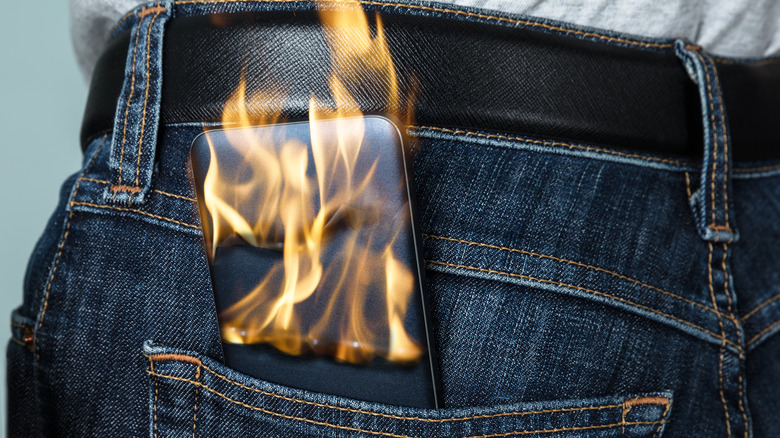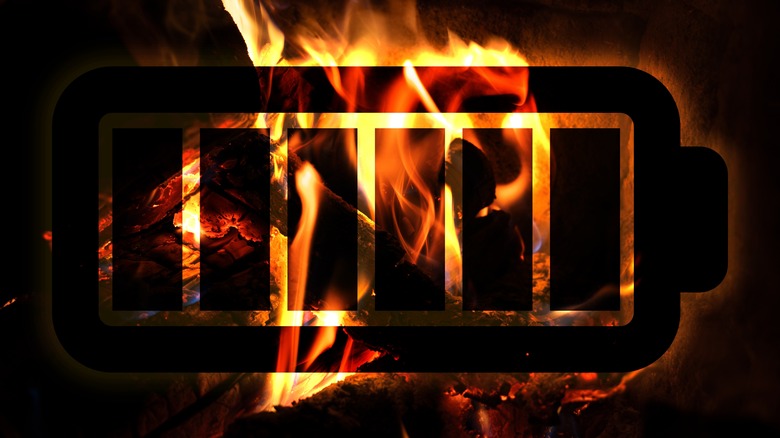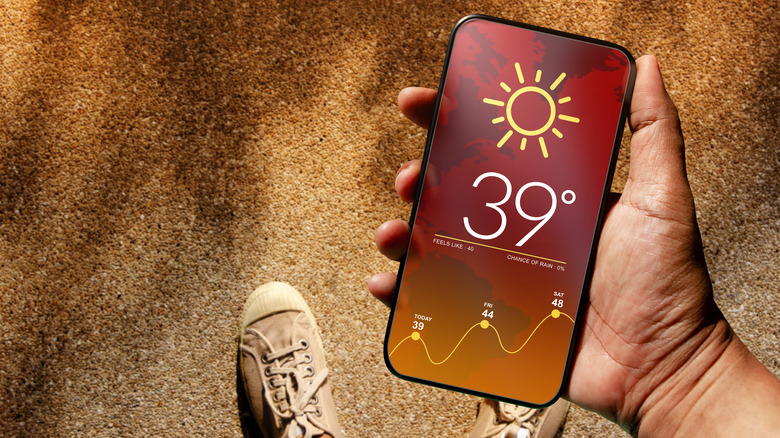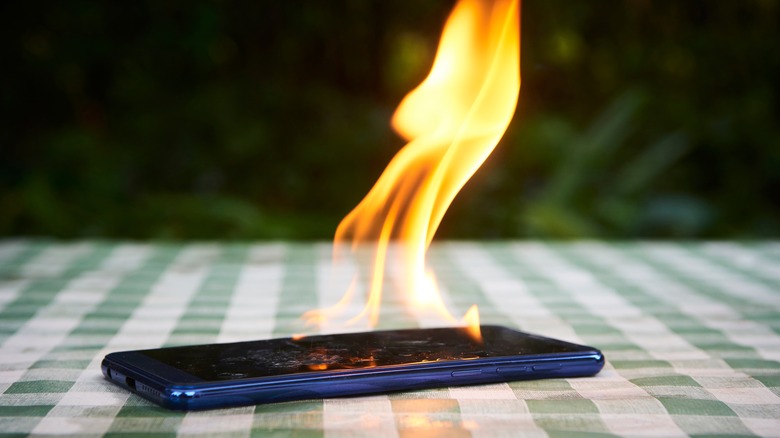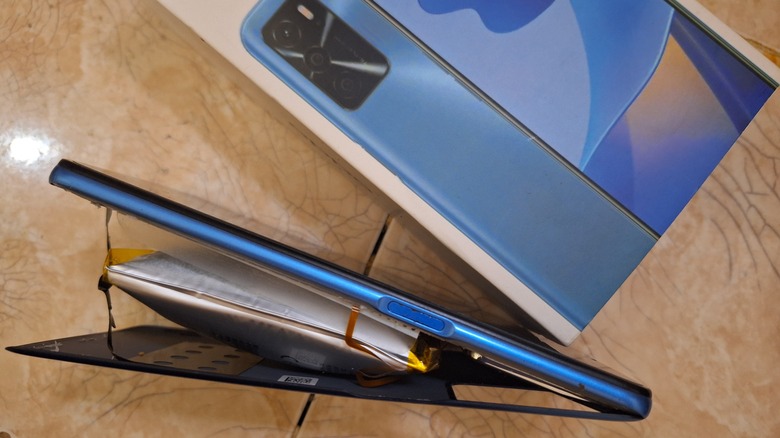4 Tips To Stop Your Phone From Overheating This Summer
As the summer approaches, pools, beaches, and barbecues begin to occupy our time. But while you're soaking up rays, so is your smartphone, and it's your wallet that will pay the price when your phone suffers damage from overheating. Last summer was the hottest on record by a large amount, and this year could be even more sweltering, so it's more important than ever to keep both you and your smartphone from suffering the effects of excess heat.
Ideal internal temperatures for a phone range from about 0 to 35 degrees Celsius (32 to 95 degrees Fahrenheit), a fairly wide range. However, those are internal temperatures, and outdoor temperatures that do not exceed the top of that range can still cause the internals of your phone to exceed them. Your phone is simply a miniaturized computer, and all computers generate heat in the course of normal operation. But dissipating that heat is essential to keeping a computer healthy, since too much of it can damage components or cause a system failure. In extremely rare cases, too much heat can cause a phone's battery to catch fire, but more often it will simply degrade the battery's lifespan and prevent you from maximizing your battery life.
There are steps you probably take to keep yourself safe from heat. You might apply sunscreen, drink extra water, or avoid direct sunlight. Similarly, there are plenty of steps you can take to prevent your phone from overheating. From keeping it out of the sun to being careful when you charge it, here are some tips that should keep your phone happy and healthy through the dog days of summer.
Keep your phone out of direct sunlight
The most important tip for those hoping to help phones beat the heat is to keep them out of direct sunlight. Essentially, your phone should live by vampire rules during the hottest parts of the year, which means you should avoid exposing it to direct sunlight when possible, and you should never leave it to bake there. That's because the inside of your phone is a bit like the inside of a car on a hot day. It traps heat and becomes a miniature oven for the components inside. Your phone's passive cooling system acts as the car's A/C in this comparison, but it's the lowest setting your car's A/C has. In other words, your phone is capable of keeping itself cool in normal temperatures, but in high temperatures it can't keep up with the heat generated by both its own operations and that entering from the outside.
If you must use your phone outdoors in direct sunlight, try to keep that usage to a bare minimum. Fire off that text to your partner or spouse, but put the phone away afterward instead of checking your social media. And there's more you can do to mitigate damage. If you're by the beach or pool, put your phone in a shaded spot. Importantly, do not cover it with a jacket or blanket, as this can trap even more heat around the phone. If you're in the car, do not keep your phone up on the dashboard, especially if you're also using your phone's GPS navigation, as that activity can generate lots of heat.
Do not charge your phone in a hot area
For the same reason you shouldn't expose it to direct sunlight, another thing you should never do in hot environments is charge your phone. Charging the phone causes the battery to heat up, and in an environment that's already hot enough to cause your phone to overheat, the added heat from charging it can often be enough to push a phone over the edge. It might be tempting to use that portable charger you brought along to the beach, but even if your phone is close to dead, wait until you're in a cooler environment to resuscitate it. If you must charge up, make sure to use a manufacturer-approved charger.
Even worse than cable charging is wireless charging. That's because wireless charging is incredibly inefficient. You may have noticed that the fastest wireless chargers still don't charge very fast, and that's for two reasons. First, about 20-50% of the energy used escapes between the charging pad and your phone, and second, as those who paid attention in physics class will have guessed, that escaping energy converts into the exact thing we're trying to avoid: heat.
One of the most common scenarios for battery-destroying heat is charging your phone in the car. We all know how hot a car dashboard can get in the summer. Many of the best car phone mounts have built-in wireless charging pads, so if you use one, make sure its wireless charging capabilities are off before mounting your phone. And, of course, you shouldn't plug it into a wired charger, either. Many smartphone owners have pulled their phone from its car dock only to find a battery swelling up and destroying the rest of the phone in the process.
Don't use your phone for intensive tasks in hot areas
There are many things your phone is capable of that will cause it to heat up even when the weather is more amenable to its operation. Games are a surefire way to get your processor pumping, especially those with lots of movement. Video editing, local AI tasks, streaming high-resolution video, and even using the camera for long periods of time can all cause even the most cutting-edge flagship smartphone to start sweating. Of course, if you do any of these things when the air around you is already blistering, your phone could seriously overheat. Additionally, these tasks will run down the battery, draining it very quickly.
If you're thinking of recreating the volleyball sequence from "Top Gun" with your smartphone camera, or of playing some "Genshin Impact" while reclining poolside, it may be wise to hold off, or to limit your usage to a few minutes at a time. While intensive tasks are not always guaranteed to cause overheating, even in the sun, it's best not to risk it.
You should also be cognizant of your phone's brightness level. Many phones with auto-brightness will default to full brightness in direct sunlight in an effort to help you see the screen more clearly, but the display is one of the biggest power draws on any smartphone or tablet. Powering all those pixels can cause your phone to get quite warm, which can again lead to overheating in high ambient temperatures. If you must check your phone, keep the brightness as low as possible. If you must turn it all the way up to see what's on the screen, try to limit your usage as much as possible.
How to cool your phone down
If you notice signs that your smartphone may be overheating, such as it being warm to the touch, struggling to perform, or displaying a warning that it is overheating, the first thing you need to do is move it out of the sunlight and to a cool location indoors. If an indoor location is not available, move it to the shade. Do not cover it with a coat or blanket, as this will trap even more heat around it. Do not put it in the refrigerator or freezer, no matter how enticing an idea it may seem. Immediately shifting from very hot to very cold temperatures is another surefire way to damage your device.
After taking it indoors, place it in front of an air vent or fan. If the phone is in a case, remove it, as this will give the phone some much needed "breathing room," so to speak, allowing it to release heat from all sides. You can also close all your running apps, reducing the energy currently being used by the phone, turn on airplane mode to stop the heat generated by cellular, Bluetooth, Wi-Fi, and GPS radios, and even switch into the low battery mode in your phone's settings (how to enable battery saver can be different across Android devices, but here's how to enable low-power mode on iPhone).
However, if your phone is more than just warm to the touch — if, for instance, it's at all painfully hot to the touch — you shouldn't bother fiddling with the software. It's safer to simply shut the phone off entirely. Most phones will shut themselves down when they get too hot, but there may be times when it fails to do so. Better to miss a call than to need a new battery or phone.
What to do if your battery pillows
One of the biggest dangers that can result from letting your phone overheat is that the battery can begin to swell up inside the phone. This is often referred to as "pillowing" because of the shape the battery deforms into, and there's even a Reddit community, r/spicypillows, dedicated to this issue. What occurs when this phenomenon takes places is that the naturally occurring gases released inside the battery during the charging process have built up too much. With nowhere left to go, these gases begin to fill up the interior of the battery's casing like a balloon. In smartphones, this can be especially damaging because, as the battery expands, it pushes against the front and back of the phone, damaging the components nearby it and even cracking the screen or backplate.
Pillowed batteries also have a much greater risk of catching fire, which makes them dangerous. If your battery swells from overheating, your best bet is to turn the phone off entirely and place it somewhere cool and non-flammable. If you have the know-how to do so, open the phone and remove the battery. Otherwise, bring it to your local repair shop (or Genius Bar for iPhones). According to experts interviewed by The Washington Post, you can drop the battery in a bucket of sand to keep it from causing any damage (not your whole phone, just the swollen battery, as sand has the potential to damage your phone further). You should then contact a battery recycling facility to dispose of it properly.
